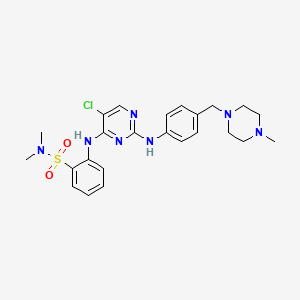Dubermatinib, 1341200-45-0, TP-0903, TP0903, 2-((5-chloro-2-((4-((4-methylpiperazin-1-yl)methyl)phenyl)amino)pyrimidin-4-yl)amino)-N,N-dimethylbenzenesulfonamide, TP 0903, Dubermatinib [USAN], CHEMBL2022968, HCl-2084, compound 13, 14D65TV20J, 2-[[5-chloro-2-[4-[(4-methylpiperazin-1-yl)methyl]anilino]pyrimidin-4-yl]amino]-N,N-dimethylbenzenesulfonamide, 2-{[5-chloro-2-({4-[(4-methylpiperazin-1-yl)methyl]phenyl}amino)pyrimidin-4-yl]amino}-N,N-dimethylbenzene-1-sulfonamide, YUAALFPUEOYPNX-UHFFFAOYSA-N, 2-{[5-chloro-2-({4-[(4-methylpiperazin-1-yl)methyl]phenyl}amino)pyrimidin-4-yl]amino}-N,N-dimethylbenzenesulfonamide, DUBERMATINIB [INN], DUBERMATINIB [WHO-DD], UNII-14D65TV20J, GTPL8863, SCHEMBL12813478, EX-A609, AMY10826, BCP15884, BDBM50382425, MFCD28502172, NSC798200, WHO 10925, AKOS026750306, CCG-269819, CS-4281, DB15187, NSC-798200, SB17174, NCGC00481577-01, AC-30945, AS-55868, DA-45909, HY-12963, FT-0700169, S7846, A900291, J-690134, Q27089011, 2-((5Chloro-2-((4-((4-methylpiperazin-1-yl)methyl)phenyl)amino)pyrimidin-4-yl)amino)-N,N-dimethylbenzenesulfonamide, 35-CHLORO-N,N,74-TRIMETHYL-2,4-DIAZA-3(4,2)-PYRIMIDINA-7(1)-PIPERAZINA-1(1),5(1,4)-DIBENZENAHEPTAPHANE-12-SULFONAMIDE, BENZENESULFONAMIDE, 2-((5-CHLORO-2-((4-((4-METHYL-1-PIPERAZINYL)METHYL)PHENYL)AMINO)-4-PYRIMIDINYL)AMINO)-N,N-DIMETHYL-



